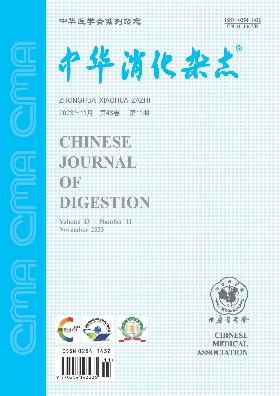Early kidney injury in patients with non-alcoholic fatty liver disease: a cross-sectional study
引用次数: 0
Abstract
Objective To investigate early kidney injury in the patients with non-alcoholic fatty liver disease (NAFLD) without hypertension, diabetes and history of kidney diseases, as so to provide evidence for preventing early kidney injury in patients with NAFLD. Methods From December 2014 to January 2016, 169 subjects visiting Sichuan Provincial People′s Hospital were recruited. Among them, 104 cases were in NAFLD group, 31 cases were in simple obesity group (overweight or obesity), and 34 subjects were in the healthy control group. The general data, biochemical indexes, metabolic indexes, biochemical indexes of kidney, and early kidney injury makers, including serum β2-microglobulin, urinary albumin and creatinine ratio (ACR) and estimated glomerular filtration rate (eGFR), were detected. Least significant difference-t test, chi-square test and Spearman correlation analysis were performed for statistical analysis. Results Compared with simple obesity group, alanine aminotransferase (ALT), aspartate aminotransferase (AST), γ-glutamyl transpeptadase (GGT), fasting insulin level, homeostasis model assessment-insulin resistance (HOMA-IR), serum creatinine, ACR and β2 microglobulin were higher in NAFLD group ((21.13±8.14) U/L vs. (66.20±44.34) U/L, (24.80±9.57) U/L vs. (49.78±25.41) U/L, (19.26±7.88) U/L vs. (66.53±56.34) U/L, (7.03±1.52) mU/L vs. (9.55±5.41) mU/L, 1.22±0.38 vs. 2.23±2.01, (62.90±10.01) μmol/L vs. (71.75±10.80) μmol/L, (4.41±1.16) μg/mg vs. (13.76±9.56) μg/mg, (1.46±0.26) mg/L vs. (2.01±0.53) mg/L); however the eGFR was lower (112.46±11.90) mL·min-1·(1.73 m2)-1 vs. (101.09±17.17) mL·min-1·(1.73 m2)-1). The differences were statistically significant (t=9.825, 8.250, 8.288, 4.229, 4.121, 4.007, 9.732, 7.792 and -3.443, all P 0.05). Compared with healthy control group, the renal injury indexes serum creatinine, ACR and β2 microglobulin of NAFLD group were higher((58.78±7.77) μmol/L vs. (71.75±10.80) μmol/L, (1.01±0.32) μg/mg vs. (13.76±9.56) μg/mg, (1.12±0.15) mg/L vs. (2.01±0.53) mg/L), and the eGFR was lower ((115.10±12.59) mL·min-1·(1.73 m2)-1 vs. (101.09±17.17) mL·min-1·(1.73 m2)-1). The differences were statistically significant (t=7.621, 13.591, 15.126 and -5.120, all P<0.01). Compared with healthy control group, the renal injury indexes ACR and β2 microglobulin of simple obesity group were higher ((1.01±0.32) μg/mg vs. (4.41±1.16) μg/mg, (1.12±0.15) mg/L vs. (1.46±0.26) mg/L), and the differences were statistically significant (t=9.732 and 7.792, both P<0.01). ACR of NAFLD patients was positively correlated with body mass index, waist circumference, triglyceride level, total cholesterol level, low density lipoprotein level, fasting blood glucose level, two-hour postprandial blood glucose, fasting insulin level and HOMA-IR (r=0.554, 0.327, 0.314, 0.353, 0.176, 0.195, 0.552, 0.364 and 0.987, all P<0.05), and was negatively correlated with high density lipoprotein (r=-0.330, P<0.01). Conclusions NAFLD is closely related with chronic kidney disease at same baseline of gender, age, blood glucose, blood lipids, and blood pressure. Abnormal metabolism of glycolipids, obesity and insulin resistance may be the mechanisms of early kidney injury in NAFLD patients. Combination of ACR and β2 microglobulin are more sensitive than serum creatinine and eGFR in detecting early renal injury in NAFLD patients. Key words: Nonalcoholic fatty liver disease; Obesity; Chronic kidney disease; Early kidney injury非酒精性脂肪肝患者早期肾损伤:一项横断面研究
目的探讨无高血压、糖尿病、无肾脏病史的非酒精性脂肪性肝病(NAFLD)患者早期肾损伤情况,为预防NAFLD患者早期肾损伤提供依据。方法选取2014年12月至2016年1月在四川省人民医院就诊的患者169例。其中,NAFLD组104例,单纯性肥胖组(超重或肥胖)31例,健康对照组34例。检测一般资料、生化指标、代谢指标、肾脏生化指标及早期肾损伤标志物,包括血清β2-微球蛋白、尿白蛋白与肌酐比值(ACR)和肾小球滤过率(eGFR)。采用t检验、卡方检验和Spearman相关分析进行统计学分析。结果与单纯性肥胖组比较,NAFLD组丙氨酸转氨酶(ALT)、天冬氨酸转氨酶(AST)、γ-谷氨酰转肽酶(GGT)、空腹胰岛素水平、稳态模型评估-胰岛素抵抗(HOMA-IR)、血清肌酐、ACR、β2微球蛋白升高((21.13±8.14)U/L vs(66.20±44.34)U/L、(24.80±9.57)U/L vs(49.78±25.41)U/L、(19.26±7.88)U/L vs(66.53±56.34)U/L、(7.03±1.52)mU/L vs(9.55±5.41)mU/L、(1.22±0.38)vs(2.23±2.01)、(62.90±10.01)μmol / L和(71.75±10.80)μmol / L(4.41±1.16)μg / mg和μg /毫克(13.76±9.56),(1.46±0.26)mg / L和(2.01±0.53)mg / L);eGFR(112.46±11.90)mL·min-1·(1.73 m2)-1低于(101.09±17.17)mL·min-1·(1.73 m2)-1)。差异有统计学意义(t=9.825、8.250、8.288、4.229、4.121、4.007、9.732、7.792、-3.443,P均为0.05)。与健康对照组相比,NAFLD组肾损伤指标血清肌酐、ACR、β2微球蛋白升高((58.78±7.77)μmol/L vs(71.75±10.80)μmol/L,(1.01±0.32)μmol/ mg vs(13.76±9.56)μmol/ mg,(1.12±0.15)mg/L vs(2.01±0.53)mg/L), eGFR降低((115.10±12.59)mL·min-1·(1.73 m2)-1 vs(101.09±17.17)mL·min-1·(1.73 m2)-1)。差异有统计学意义(t=7.621、13.591、15.126、-5.120,P均<0.01)。与健康对照组比较,单纯性肥胖组肾损伤指标ACR、β2微球蛋白升高((1.01±0.32)μg/mg vs(4.41±1.16)μg/mg,(1.12±0.15)mg/L vs(1.46±0.26)mg/L),差异均有统计学意义(t=9.732、7.792,P均<0.01)。NAFLD患者ACR与体重指数、腰围、甘油三酯水平、总胆固醇水平、低密度脂蛋白水平、空腹血糖水平、餐后2小时血糖、空腹胰岛素水平、HOMA-IR呈正相关(r=0.554、0.327、0.314、0.353、0.176、0.195、0.552、0.364、0.987,均P<0.05),与高密度脂蛋白呈负相关(r=-0.330, P<0.01)。结论在性别、年龄、血糖、血脂、血压基线相同的情况下,NAFLD与慢性肾脏疾病密切相关。糖脂代谢异常、肥胖和胰岛素抵抗可能是NAFLD患者早期肾损伤的机制。ACR和β2微球蛋白联合检测NAFLD患者早期肾损伤的敏感性高于血清肌酐和eGFR。关键词:非酒精性脂肪肝;肥胖;慢性肾病;早期肾损伤
本文章由计算机程序翻译,如有差异,请以英文原文为准。
求助全文
约1分钟内获得全文
求助全文

 求助内容:
求助内容: 应助结果提醒方式:
应助结果提醒方式:


